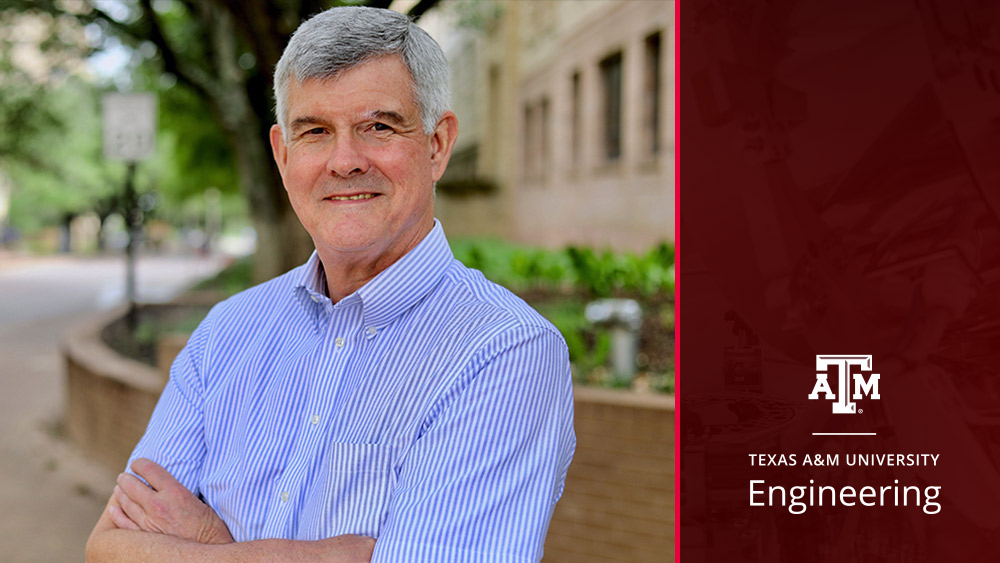
Dr. George M. Pharr, professor and Erle Nye ’59 Chair I in the Department of Materials Science and Engineering at Texas A&M University, was recently named a 2022 University Distinguished Professor.
The designation of University Distinguished Professor is the highest faculty honor at Texas A&M and was awarded to only six faculty members in 2022. The distinction is given to faculty members who are considered pre-eminent in their field and have made transformational contributions to their discipline.
“This honor is very meaningful to me,” Pharr said. “I am very appreciative of what the university has done for me.”
Pharr came to Texas A&M in 2017 after working for 18 years at Rice University in Houston and 18 years in a joint faculty appointment at the University of Tennessee and Oak Ridge National Laboratory.
Texas A&M recruited him through the Chancellor’s Research Initiative and the Governor’s University Research Initiative (GURI). The GURI recruits distinguished researchers from outside Texas and provides grant funding for their institutions to bring experienced and accomplished researchers and professors into the state.
Pharr received a doctorate in materials science and engineering from Stanford in 1979. In 2014, he was elected to the National Academy of Engineering. Throughout his 40 years of research, he has focused on measuring material strength at the nanoscale. The method he pioneered has been named nanoindentation.
“Nanoindentation is the process by which a very sharp diamond is pushed into an object with nanoscale dimensions,” Pharr said. “The diamond is pushed into the object until it deforms or breaks, which determines the strength of the nanoscale object.”
In his five years at Texas A&M, Pharr has already made a large impact on the university and the Department of Materials Science and Engineering.
“I consider him the father of nanoindentation,” said Dr. Ibrahim Karaman, department head of the Department of Materials Science and Engineering. “He has made a significant impact on the growth and depth of research in our department.”
Nanoindentation was initially developed for electronics. In the 1990s, the importance of nanoindentation grew with the boom of the semiconductor industry. Semiconductors use silicon wafers with very thin films to create the chips used in many electronics such as computers, phones and watches.
As the use of electronics grew in the 1990s, Pharr assisted with the creation of a thin film that covers the disks in hard drives. The magnetic material on these disks, where data is stored, is extremely sensitive and prone to breaking. To write or read information on the disk, the read head must be very close to the disk, just a few nanometers away. Without Pharr’s knowledge of nanoindentation, any slight bump or jostle could cause the disk, and stored data, to be damaged when the read head impacts it. To solve this problem, Pharr assisted with the development of a thin film that protects the disk. During development, his technique was the only method that could accurately determine the hardness of the extremely thin film.
“The film had to be thin enough to not impact storage density, but hard enough to protect the magnetic material,” Pharr said.
Nanoindentation is now used in many industries, including health care. Recently, researchers used the technique to study changes in cancerous cells. When a cell becomes cancerous, its stiffness changes. This change can be measured to determine if an individual cell is cancerous.
In addition to pursuing his research, Pharr has taught university students for more than 40 years. For his contributions to the materials science and engineering field, Pharr has received many honors, including the inaugural Innovation in Materials Characterization Award (2010) given by the Materials Research Society and the Nadai Medal (2018) from the American Society of Mechanical Engineers. In 2021, Pharr received the William D. Nix Award from the Minerals, Metals, and Materials Society for his development of nanoindentation and fundamental contributions to the field of contact mechanics. He is a fellow of the American Society of Metals International (1995), the Materials Research Society (2012) and the Minerals, Metals & Materials Society (2016). Since 1990, he has served as an associate editor of the Journal of the American Ceramic Society and principal editor of the Journal of Materials Research since 2012.
With his vast experience and many accolades, Pharr’s passion for his research and making a difference has only grown.
“I hope to continue to be active in my research,” Pharr said. “I still very much enjoy what I do.”